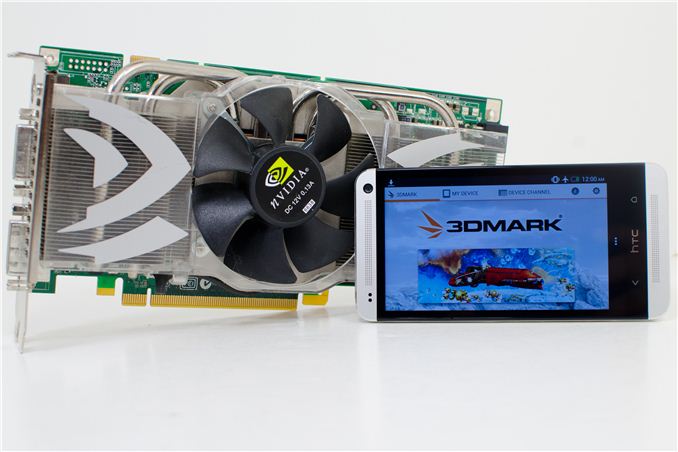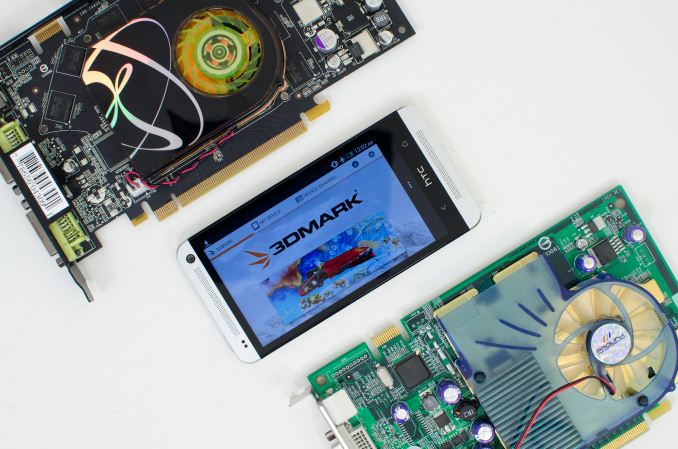The Great Equalizer 3: How Fast is Your Smartphone/Tablet in PC GPU Terms
by Anand Lal Shimpi on April 4, 2013 1:00 AM EST- Posted in
- Tablets
- Smartphones
- Mobile
- GPUs
- SoCs

For the past several days I've been playing around with Futuremark's new 3DMark for Android, as well as Kishonti's GL and DXBenchmark 2.7. All of these tests are scheduled to be available on Android, iOS, Windows RT and Windows 8 - giving us the beginning of a very wonderful thing: a set of benchmarks that allow us to roughly compare mobile hardware across (virtually) all OSes. The computing world is headed for convergence in a major way, and with benchmarks like these we'll be able to better track everyone's progress as the high performance folks go low power, and the low power folks aim for higher performance.
The previous two articles I did on the topic were really focused on comparing smartphones to smartphones, and tablets to tablets. What we've been lacking however has been perspective. On the CPU side we've known how fast Atom was for quite a while. Back in 2008 I concluded that a 1.6GHz single core Atom processor delivered performance similar to that of a 1.2GHz Pentium M, or a mainstream Centrino notebook from 2003. Higher clock speeds and a second core would likely push that performance forward by another year or two at most. Given that most of the ARM based CPU competitors tend to be a bit slower than Atom, you could estimate that any of the current crop of smartphones delivers CPU performance somewhere in the range of a notebook from 2003 - 2005. Not bad. But what about graphics performance?
To find out, I went through my parts closet in search of GPUs from a similar time period. I needed hardware that supported PCIe (to make testbed construction easier), and I needed GPUs that supported DirectX 9, which had me starting at 2004. I don't always keep everything I've ever tested, but I try to keep parts of potential value to future comparisons. Rest assured that back in 2004 - 2007, I didn't think I'd be using these GPUs to put smartphone performance in perspective.
Here's what I dug up:
| The Lineup (Configurations as Tested) | |||||||||||||
| Release Year | Pixel Shaders | Vertex Shaders | Core Clock | Memory Data Rate | Memory Bus Width | Memory Size | |||||||
| NVIDIA GeForce 8500 GT | 2007 | 16 (unified) | 520MHz (1040MHz shader clock) | 1.4GHz | 128-bit | 256MB DDR3 | |||||||
| NVIDIA GeForce 7900 GTX | 2006 | 24 | 8 | 650MHz | 1.6GHz | 256-bit | 512MB DDR3 | ||||||
| NVIDIA GeForce 7900 GS | 2006 | 20 | 7 | 480MHz | 1.4GHz | 256-bit | 256MB DDR3 | ||||||
| NVIDIA GeForce 7800 GT | 2005 | 20 | 7 | 400MHz | 1GHz | 256-bit | 256MB DDR3 | ||||||
| NVIDIA GeForce 6600 | 2004 | 8 | 3 | 300MHz | 500MHz | 128-bit | 256MB DDR | ||||||
I wanted to toss in a GeForce 6600 GT, given just how awesome that card was back in 2004, but alas I had cleared out my old stock of PCIe 6600 GTs long ago. I had an AGP 6600 GT but that would ruin my ability to keep CPU performance in-line with Surface Pro, so I had to resort to a vanilla GeForce 6600. Both core clock and memory bandwidth suffered as a result, with the latter being cut in half from using slower DDR. The core clock on the base 6600 was only 300MHz compared to 500MHz for the GT. What does make the vanilla GeForce 6600 very interesting however is that it delivered similar performance to a very famous card: the Radeon 9700 Pro (chip codename: R300). The Radeon 9700 Pro also had 8 pixel pipes, but 4 vertex shader units, and ran at 325MHz. The 9700 Pro did have substantially higher memory bandwidth, but given the bandwidth-limited target market of our only cross-platform benchmarks we won't always see tons of memory bandwidth put to good use here.
The 7800 GT and 7900 GS/GTX were included to showcase the impacts of scaling up compute units and memory bandwidth, as the architectures aren't fundamentally all that different from the GeForce 6600 - they're just bigger and better. The 7800 GT in particular was exciting as it delivered performance competitive with the previous generation GeForce 6800 Ultra, but at a more attractive price point. Given that the 6800 Ultra was cream of the crop in 2004, the performance of the competitive 7800 GT will be important to look at.
Finally we have a mainstream part from NVIDIA's G8x family: the GeForce 8500 GT. Prior to G80 and its derivatives, NVIDIA used dedicated pixel and vertex shader hardware - similar to what it does today with its ultra mobile GPUs (Tegra 2 - 4). Starting with G80 (and eventually trickling down to G86, the basis of the 8500 GT), NVIDIA embraced a unified shader architecture with a single set of execution resources that could be used to run pixel or vertex shader programs. NVIDIA will make a similar transition in its Tegra lineup with Logan in 2014. The 8500 GT won't outperform the 7900 GTX in most gaming workloads, but it does give us a look at how NVIDIA's unified architecture deals with our two cross-platform benchmarks. Remember that both 3DMark and GL/DXBenchmark 2.7 were designed (mostly) to run on modern hardware. Although hardly modern, the 8500 GT does look a lot more like today's architectures than the G70 based cards.
You'll notice a distinct lack of ATI video cards here - that's not from a lack of trying. I dusted off an old X800 GT and an X1650 Pro, neither of which would complete the first graphics test in 3DMark or DXBenchmark's T-Rex HD test. Drivers seem to be at fault here. ATI dropped support for DX9-only GPUs long ago, the latest Catalyst available for these cards (10.2) was put out well before either benchmark was conceived. Unfortunately I don't have any AMD based ultraportables, but I did grab the old Brazos E-350. As a reminder, the E-350 was a 40nm APU that used two Bobcat cores and featured 80 GPU cores (Radeon HD 6310). While we won't see the E-350 in a tablet, a faster member of its lineage will find its way into tablets beginning this year.











128 Comments
View All Comments
IntelUser2000 - Thursday, April 4, 2013 - link
@zlim:It would be lot closer, because the HD 4000 in the regular variant is only 50-60% faster than the HD 3000. The HD 4000 in ULV is maybe only 30-40% faster.
zeo - Tuesday, April 16, 2013 - link
Mind though that the iPad is using a quad GPU, while the Intel GMA's are single GPUs... Also this isn't counting discrete graphic cards, which scale much higher than Integrate GPU's can go. Even AMD's best APU still barely provides what would be a mid-range discrete graphic card performance.ltcommanderdata - Thursday, April 4, 2013 - link
These results seem to suggest that high-end mobile GPUs are very close to current-gen consoles (nVidia 7900 class) and that the HD4000 is faster than current-gen consoles. Based on realizable graphics in games it doesn't seem that close although that may be advantages in bandwidth and close-to-metal access showing through."Again, the new 3DMark appears to unfairly penalize the older non-unified NVIDIA GPU architectures. Keep in mind that the last NVIDIA driver drop for DX9 hardware (G7x and NV4x) was last October, before either benchmark had been released. The 8500 GT on the other hand gets the benefit of a driver released this month."
You mentioned you were using nVidia drivers from October 2012, but the latest legacy drivers for the 6000/7000 series is GeForce 307.83 from February 2013 for Windows 7 and GeForce 307.74 from January 2013 for Windows 8.
perry1mm - Thursday, April 4, 2013 - link
This will be speaking in terms of mobile graphics for the HD 4000:Combined with the proper specs (fast RAM, higher clocked processor frequencies without the TDP holding it back from turbo-boosting, and a higher allocation of VRAM) should come out to 125-150% better performance than the PS3 or Xbox 360, from the comparisons I have done.
Such as most games that run 1080p on PS360 (if that's even the native resolution, doubtful for most) are locked at 30FPS and for PC would be "low" settings and likely low or no AA. I can run similar games on my Vaio Duo 11 @ 1080p with low settings and low or no AA at more consistent framerates than 30. I've looked up graphical capabilities (settings) on the consoles such as Skyrim, DmC, L4D2, Borderlands 2, Far Cry 2, Deus Ex: Human Revolution, and more...and it seems when consoles are running them at 30FPS I can consistently get 35-40, if not higher.
perry1mm - Thursday, April 4, 2013 - link
Oh, and in reference to the "proper specs" with the HD 4000 in my Sony Vaio Duo 11, I have the i7 3537u (turbo-boost to 3.1Ghz) with 8GB 1600Mhz DDR3 RAM.jeffkibuule - Thursday, April 4, 2013 - link
No game runs at 1080p on the PS3/360. It's mostly 720p60, 720p30, and even 640p(30-60). 1080p is a pipe dream on current consoles.Friendly0Fire - Thursday, April 4, 2013 - link
There was one notable exception: Wipeout HD has always run at 60fps and 1080p and looked superb for it.SlyNine - Friday, April 5, 2013 - link
Actually there are a few games that run in 1080p@60. Soul Calibur is rendered at 1080p for instance.Sorry you didn't know or bother checking the facts before you posted misinformation just to help prove your point.
A point that I agree with, but I hate misinformation.
Anand Lal Shimpi - Thursday, April 4, 2013 - link
You are correct, the drivers were from February 2013 not October. I'm not sure why we thought October. I've updated the article accordingly :)When HD 3000 launched, the unofficial word was that GPU was the first integrated GPU to finally be faster than the Xbox 360. HD 4000 is understandably quicker. The ultra mobile GPUs (likely in tablets first) will be faster than the current gen consoles in the next 1 - 2 years. Combine that with the fact that one of the ultra mobile players happens to be a big game publisher for a major console and you begin to have a rough outline of what could look like a giant trump card. Whether or not they ever play it is another question entirely.
Take care,
Anand
Ryan Smith - Thursday, April 4, 2013 - link
I'm the one who came up with October, since that was when NVIDIA moved their DX9 cards to legacy. I had not realized there had been an interim driver release. Though it's worth noting that legacy cards don't get performance optimizations, only bug fixes. So there still would not be any optimizations in those drivers for the new benchmarks.